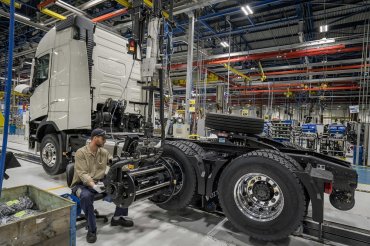RIO DE JANEIRO, Brazil – After several years of tribulation, Brazils economy is making a much-awaited recovery. An economist said recently that that recovery is of great interest to the nations lubricant market and – given its status as far the largest and most populated country in Latin America – to those of neighboring countries.
The automobile industry represents 25 percent of Brazils industrial production, only behind computing with 28 percent, according to local economist Guilherme Merces who spoke at a lubricant industry conference in Rio de Janeiro last month.

Photo courtesy of Volvo
Workers assemble a Volvo tractor-trailer on an assembly line at a manufacturing plant in Brazil. The automobile industry represents 25 percent of Brazils industrial production, an economist said at the Meet the Market South America International Conference in Rio de Janeiro last month.
After a two-year economic crisis from 2015 to 2016, vehicle sales are rebounding impressively in 2018 – up 17.7 percent compared to the same period of 2017 – but Brazils overall economic recovery is not as robust as many were expecting last year, Merces said June 19 at the Meet the Market South America International Conference.
We are now expecting a [gross domestic product] increase of around 1.7 percent for 2018 and not 2.2 percent like in previous forecasts, explained Merces, who is the chief economist for Rio de Janeiro state industries federation Firjan.
The estimate, however, is still in line with Latin America where an average GDP increase of nearly 1.9 percent is expected.
Brazil Risks
Merces warned that even the scaled-back recovery could still be derailed by several factors, some of which have become bigger threats in the wake of a late May strike by Brazils truck drivers – blamed on high diesel prices.
One of the risks is the Brazilian reals falling value against the U.S. dollar. On June 29, one dollar was worth 3.87 reais, up 18 percent compared to six months earlier.
If the trend continues, the central bank will be highly pressured to raise the benchmark interest rate, said Merces.
The fact that a presidential election is scheduled for October is another risk factor since it reduces chances that much-needed economic reforms will pass, reduces business and consumer confidence, puts even more pressure on the exchange rate, and could increase inflation.Currently inflation hovers around 3 percent annually, a rate that is manageable.
Neighboring Argentina presents another risk as it is mired in its own fiscal crisis. If Argentinas economy falters, that would hurt Brazilian automobile exports and could ripple through Brazils economy.
Road to Recovery
To improve the economic situation, the countrys inflation, benchmark interest rate and unemployment must be kept under control, Merces said. They are currently 3 percent, 6.5 percent and 12.7 percent, respectively.
Regarding the latter, states with the lowest unemployment rates are Sao Paulo, Minas Gerais, and Santa Catarina. The state with the highest unemployment rate is Brazils oil-rich Rio de Janeiro, followed by Alagoas and Pernambuco, according to Merces.
Rio de Janeiro needs social security and fiscal reform, as well as new concessions and public-private-partnerships to help stimulate investments, which includes the auctioning of new blocks for oil exploration, the economist said.